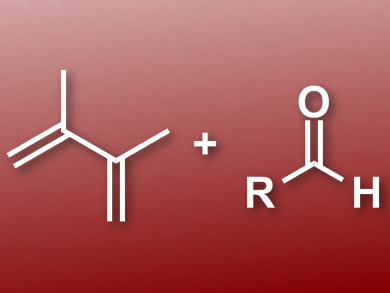To synthesize homoallylic alcohols, organic chemists often perform allylations of aldehydes. The reductive coupling of conjugated butadienes with aldehydes is one possible approach for this. However, this reaction requires expensive transition-metal catalysts.
Ikuya Shibata and colleagues, Osaka University, Japan, have developed a transition-metal-free direct coupling of 1,3-butadienes with aldehydes. The team prepared the catalyst, dibutyliodotin hydride (Bu2SnIH), in situ by combining dibutyltin diiodide (Bu2SnI2) and dibutyltin dihydride (Bu2SnH2) in acetonitrile. Then, they added a butadiene derivative, an aldehyde, Ph2SiH2 as a hydride source, and methanol as an additive, and heated the reaction mixture to 25 °C for 24 hours.
The coupling reaction tolerates a wide range of aldehydes and various dienes and proceeds in moderate to good yields. The team proposes a radical reaction mechanism, since radical scavengers inhibit the reaction. According to the researchers, the reaction could be a suitable alternative to the use of transition-metal catalysts for coupling dienes and aldehydes.
- Transition-Metal-Free Reductive Coupling of 1,3-Butadienes with Aldehydes Catalyzed by Dibutyliodotin Hydride,
Itaru Suzuki, Yuki Uji, Shujiro Kanaya, Ryosuke Ieki, Shinji Tsunoi, Ikuya Shibata,
Org. Lett. 2017.
DOI: 10.1021/acs.orglett.7b02671



